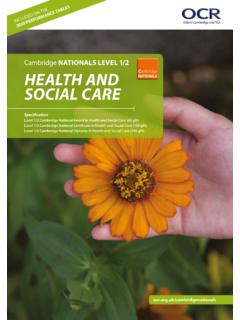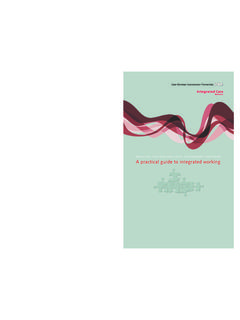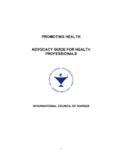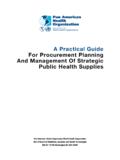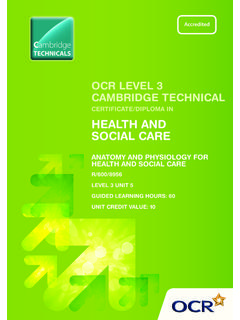Transcription of Electric profiling beds in health care - Health and Safety ...
1 Health and Safety Executive1 of 5 pages The wrong bed will waste scarce human resources and put them at risk Rabbi Julia Neuberger, former CE,The King s bed is the one piece of equipment nearly everyone working in, or usinghealth care services, will come into contact with. In the UK, many hospitaland community beds are standard hydraulic, foot pump-operated with a flatbase and pullout backrest (The King s Fund drew up its specification overforty years ago).The right bed can enhance the quality of life of those who use them. Poorlydesigned or inappropriately chosen beds can have a significant ,3 The wrong bed can lead to loss of occupant independence, work-relatedpain for staff and informal carers and increased risk of pressure have shown that the manual handling of patients in or around their bedis responsible for one-third of nurses work-related musculoskeletal and handling injuries and back painIn healthcare, around 5000 manual handling injuries are reported each year.
2 Manual handling injury accounts for 40% of all sickness absence and costs about 400 million each Royal College of Nursing (RCN) study6 identified that 52% of manual handling accidents involve hospital beds . Typically, they happen while moving patients up or down the bed, helping them to sit up or turning them in ,8 Electric profiling beds Unlike standard hydraulic beds , the bases of Electric profiling beds (EPBs) are sectioned so the mattress can be profiled to achieve various positions, the height can also be adjusted. Movement is powered and controlled via a bedside handset by care staff, and if appropriate, the patient. How the law appliesRegulation 4 of the Manual Handling Operations Regulations 1992 (as amended)
3 ,9 requires employers, so far as is reasonably practicable, to avoid the need for employees to undertake any manual handling operations which involve a risk of them being this cannot be avoided, employers must make a suitable and sufficient assessment of the task and identify steps to reduce the risk to the lowest level reasonably concept of reasonably practicable is explained at profiling beds in Health care 2 of 5 pagesHealth and Safety ExecutiveElectric profiling beds in Health careThe provision of suitable moving and handling aids and education in appropriate patient handling techniques reduces the risk. However, where patients are very dependent, and handling takes place frequently, the risk of injury remains.
4 In such cases, a risk assessment will usually find that EPBs should be provided. Introducing suitable EPBs eliminates the need for care staff to manually adjust bed backrests and bed height, and reduces manual repositioning of patients in bed, substantially reducing manual handling risk. EPBs also reduce the risk of developing pressure ulcers and enhance the patient benefitsErgonomic comparison between moving patients on standard beds and EPBs confirms the significant reduction in risk of injury to staff. For example, ergonomic assessment of adjusting backrests suggests a high risk of injury from using unmodified This task is eliminated by providing Also, being able to adjust bed height easily means staff are more likely to adjust the height of the bed for patient handling or making patients sitting in standard beds tend to slide down and can have difficulty readjusting their position without help.
5 Being able to control the bed profile means EPBs reduce this risk and associated pressure damage. Patients are also able to reposition themselves more independently. Hence the number of patient handling tasks is reduced, further lowering the risk of need to educate staff in using EPBs to maximise their benefits. For example, staff need to know how to use the knee break to prevent patients slipping down the bed. In summary, EPBs eliminate many patient handling tasks and reduce the risks from those that should you provide profiling beds ?Healthcare organisations should undertake individual patient and generic assessments of their manual handling activities.
6 In hospital settings, these should be done on a ward-by-ward basis. Assessments should identify necessary handling aids and consider whether EPBs are required. Orthopaedic, care of the elderly, stroke rehabilitation and critical care wards will have dependent patients and are all examples of where EPBs are likely to be required. Under some circumstances it may not be appropriate to provide EPBs (eg acute mental Health environments).You do not need to provide EPBs where patients do not need help in bed. It is possible, for example, for a trust to provide EPBs in appropriate wards only, while retaining a number of standard beds . However, there may be practical difficulties, in ensuring that the right beds are available when and where required, which must be managed.
7 Moving patients between beds introduces unnecessary transfers with associated risks. An example of an assessment is given in Manual handling assessments in hospitals and the community: An RCN benefitsAlthough not within HSE s remit, Electric profiling beds also have a number of benefits for patients associated with the ability to alter the bed profile. Earlier upright positioning and mobilisation helps reduce the risk of pressure ulcer ,13 3 of 5 pagesHealth and Safety ExecutiveElectric profiling beds in Health careIt can also reduce other potential complications of immobility; and have a beneficial effect on major body systems,14 including:improved lung function; reduced cardiac workload and improved cardiac output; improved urinary drainage and reduced infection risk; improved gut mobility and nutrient absorption; reduced muscle wastage, while maintaining joint flexibility.
8 These clinical benefits can reduce length of patient stay and pharmacy costs. There is also evidence of a positive impact on patient satisfaction and staff to consider when introducing EPBsAlthough EPBs bring clear benefits, you need to consider a number of issues when introducing profiling bedsEPBs are significantly heavier than standard non- profiling beds and can potentially increase risk from moving them. While they should be relatively easy to manoeuvre on flat surfaces, locations with even shallow inclines may report some difficulty in moving the beds over any hospitals have purchased bed pullers to assist in transporting beds .
9 This represents an additional cost, but can be included in any total equipment management issues at profiling bedsHospital beds can be moved frequently as the patient is moved, and during cleaning. In addition to trip hazards from trailing cables, this can result in damage to Electric cables if they are not properly routed or the bed is removed while plugged in. Where pressure-relieving mattresses are used there is a risk that the mattress power cable (particularly where it runs from the bottom of the mattress to the top of the bed) may become damaged as the bed is adjusted. Where EPBs are provided, measures should be taken to reduce the likelihood and consequence of damage to the cables in line with manufacturers instructions, eg routine examination of electrical cables, fitting residual current devices (RCDs), educating staff and reporting any issues to the supplier and the Medicines and Healthcare products Regulatory Agency (MHRA).
10 Organisations will need to ensure the electrical infrastructure can accommodatethe additional load from EPBs. Additional power points may also be needed where beds are railsIntegral bed rails provided with EPBs have a number of benefits including the certainty that the rails are the correct ones for the bed and are properly fitted. There is also the additional benefit of not needing to find storage for unused bed rails. Bed rails are not suitable for all patients. Health care providers should ensure there are systems in place for assessment and safe use of bed rails, and that they are not used 4 of 5 pagesHealth and Safety ExecutiveElectric profiling beds in Health careIf overlay mattresses are used you should check their suitability with the manufacturer.










